How to Upgrade Ubuntu 20.04 to Ubuntu 22.04 LTS
Ubuntu 22.04 (Jammy Jellyfish) has officially been released. It’s the latest Ubuntu LTS release and it ships with numerous improvements and new applications such as PHP 8.1, Ruby 3.0, OpenSSL 3.0, Golang 1.18, GNOME 42, and improved support for Raspberry Pi to mention just a few. We already have a guide on how to install Ubuntu 22.04.
In case, you have Ubuntu 20.04 LTS and don’t feel like starting from scratch, you can easily upgrade to Ubuntu 22.04 using a few simple steps.
In this guide, we will demonstrate how you can upgrade Ubuntu 20.04 LTS (Focal Fossa) to Ubuntu 22.04 LTS (Jammy Jellyfish) step by step.
Prerequisites
Before you commence the upgrade, ensure that you have the following in place:
- An instance of Ubuntu 20.04 with a sudo user configured
- A high-speed internet connection. In this guide, we are using an internet connection of 15 Mbps.
- At least 10 GB of free disk space is recommended. If you have a separate boot partition, ensure that you have at least 200MB of free space on that partition.
- It is also highly recommended that you take a backup of all your files so that you do not lose your data in case something goes wrong during the upgrade.
1) Upgrade Ubuntu to the latest release
To begin the upgrade process, log in to your Ubuntu 20.04 instance and upgrade all the packages to their latest versions.
$ sudo apt update && sudo apt upgrade -y

This might take a while depending on how many packages have pending upgrades. While the upgrade is in progress. Just sit back and relax and let it continue.
Upon completion, reboot your system.
$ sudo reboot
Login once again and verify that you are running the latest release of Ubuntu 20.04, which should be Ubuntu 20.04.4.
You can verify this using the command:
$ lsb_release -a

2) Begin the Upgrade
To initiate the actual upgrade, run the following command.
$ sudo do-release-upgrade -d
The command checks for the availability of a new Ubuntu release and proceeds to download the upgrade tool.
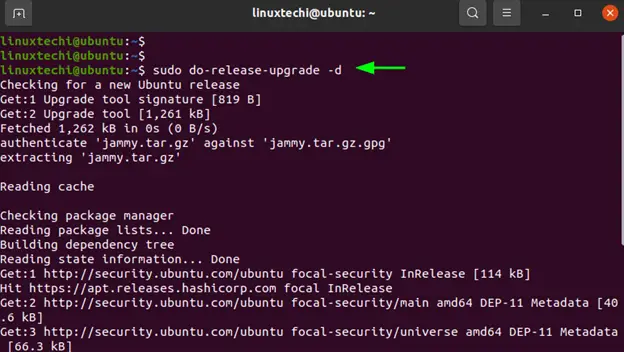
The upgrade tool performs a series of operations. It updates the local package index, checks for installed snaps, and determines their size. It then proceeds to update the repository information.
To continue, simply hit ENTER on your keyboard.
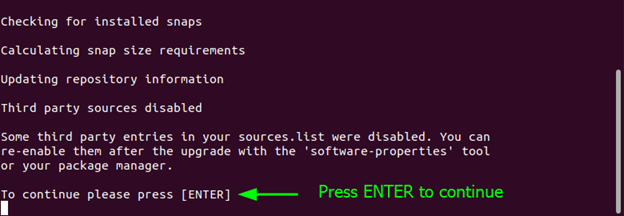
Moving on, the upgrade tool will provide you with a summary of the following:
- Packages that are no longer supported by Canonical.
- The number of obsolete packages that will be removed.
- The number of new packages that are going to be installed.
- The number of packages that are going to be upgraded
- The total download size of all the packages and the estimated time taken to download them.
To continue, type ‘y’ and hit ENTER.
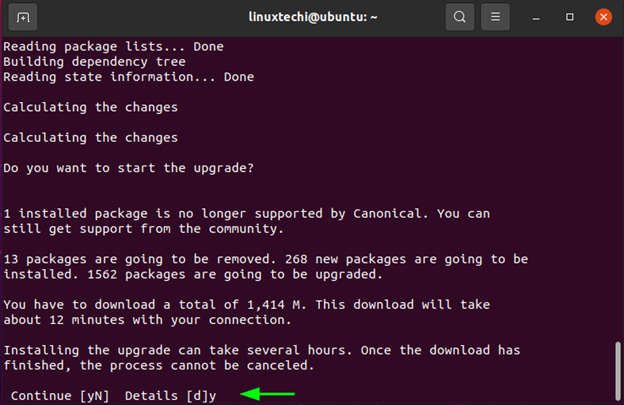
All the current ‘focal’ sources list files for Ubuntu 20.04 will be overwritten by ‘jammy’ sources list files for Ubuntu 22.04.
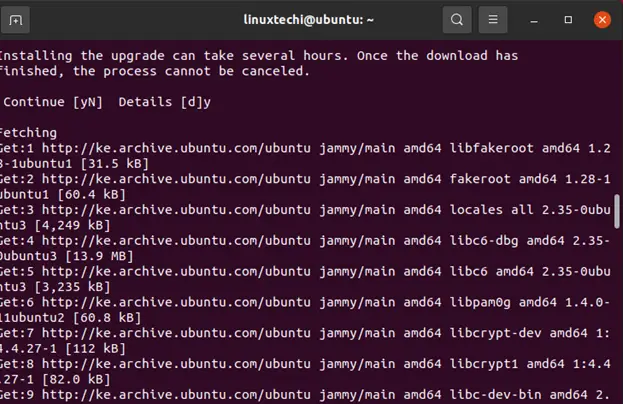
There are services installed on your system that will be affected during the upgrade and will certainly need to be restarted. Thankfully, the upgrade tool will automatically restart these services for you since manually restarting them will interrupt the upgrade process.
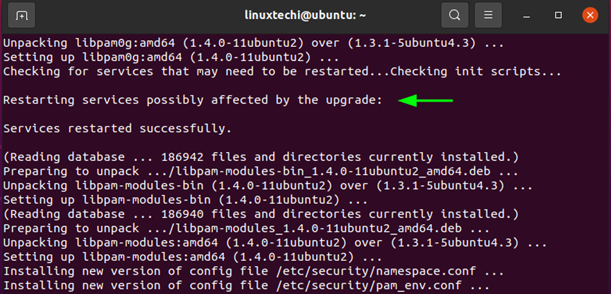
From here, the upgrade to Ubuntu 22.04 will continue. This takes quite some time as the system downloads new packages and installs them.
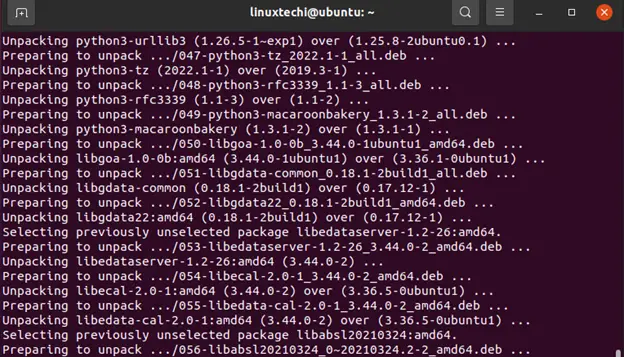
Starting from Ubuntu 22.04, Firefox will only be available to Ubuntu users via the snap package. The Firefox upgrade will automatically transition Firefox to snap. If you have an instance of Firefox running, close it and select the ‘OK’ option to transition Firefox to a snap package.
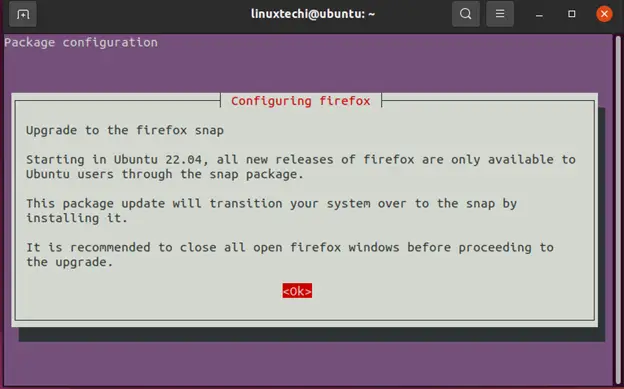
Along the way, you will be prompted to remove or purge old packages which are a by-product of the upgrade process. Press ‘y’ and hit ENTER to continue.

Finally, you will be prompted to reboot your system to complete the upgrade. Simply press ‘y’ and press ENTER to reboot.
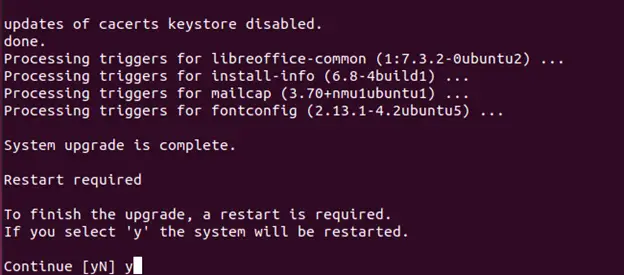
The restart will take a bit longer than usual, so just be patient. Finally, the login screen will appear. Click on your username and provide a password to log in.
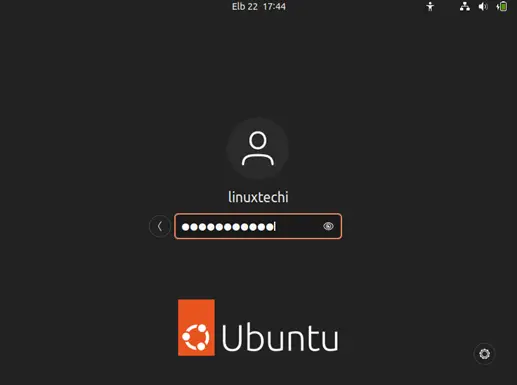
This ushers you to the Ubuntu 22.04 (Jammy Jellyfish) desktop as shown below.
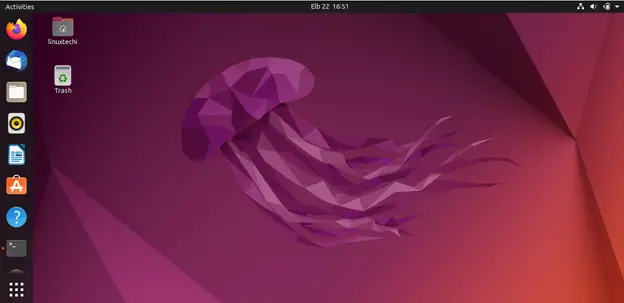
You can head over to the terminal and verify that the upgrade was successful, once again, checking the version of Ubuntu.
$ lsb_release -a

The output confirms that we have successfully upgraded from Ubuntu 20.04 to Ubuntu 22.04.
Conclusion
And there you go. We have successfully upgraded from Ubuntu 20.04 to Ubuntu 22.04 LTS which will be supported by Canonical for the next 5 years until 2027. We hope that this guide was helpful. Have a wonderful time in getting started with the latest Ubuntu LTS release in town.
The post How to Upgrade Ubuntu 20.04 to Ubuntu 22.04 LTS first appeared on LinuxTechi.
